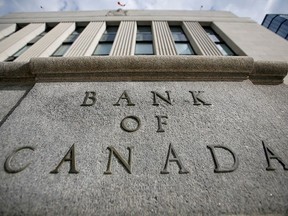June interest rate cut ‘in the realm of possibilities’: Bank of Canada
Forecasters widely expect central bank to begin lowering key rate in June as economy slows, inflation trends lower

Article content
OTTAWA • The Bank of Canada has maintained its key interest rate at five per cent, but Governor Tiff Macklem says a cut in June is now “in the realm of possibilities.”
The bank on Wednesday left rates unchanged for the sixth straight time following 10 increases that began two years ago, all in order to hike borrowing costs in attempts to weigh down consumer spending and slow the rising cost of everything.
That’s as forecasters widely expect the central bank to begin lowering its key rate in June as the economy slows and inflation trends lower.
All eyes on Wednesday were looking for signals of that happening.
“What do we need to see to be convinced it’s time to cut? The short answer is we are seeing what we need to see, but we need to see it for longer to be confident that progress toward price stability will be sustained,” said Macklem.
“The further decline we’ve seen in core inflation is very recent.
“We need to be assured this is not just a temporary dip.”
Taking questions from reporters in Ottawa on Wednesday, Macklem was then asked directly whether a June cut is now possible.
“Yes, it’s within the realm of possibilities,” he replied.
Canada’s inflation rate was 2.8 per cent in February, the second month in a row that annual inflation fell within the Bank of Canada’s target range of one-to-three per cent.
In New Brunswick, it cooled to 2.1 per cent year over year, as the rising price of groceries slowed.
The February numbers represented inflation’s slowest pace since June of last year.
That’s as unemployment in New Brunswick climbed to 7.8 per cent in March, its highest level in over two years.
It’s up nearly a percentage point from February and now two points higher than a year ago.
Canada’s unemployment rate jumped to 6.1 per cent in March, up from 5.8 per cent in February, marking the largest increase in the unemployment rate since summer 2022.
It’s a trend the bank has noticed.
“We concluded that, overall, the data since January have increased our confidence that inflation will continue to come down gradually even as economic activity strengthens,” Macklem said.
“Our key indicators of inflation have all moved in the right direction and recent data point to a pickup in economic growth.”
Macklem said that with gasoline prices rising, inflation is likely to remain around three per cent in the coming months. It is then expected to ease below 2.5 per cent in the second half of this year and reach the two per cent target in 2025.
Still, Macklem says risks remain around that forecast, noting inflation could be higher if global tensions escalate, further boosting energy prices and disrupting international shipping.
He added that house prices in Canada could rise faster than expected and wage growth could remain high relative to productivity.
On the downside, economic activity globally and in Canada could be weaker than expected, cooling demand and inflation too much.
Economists said on Wednesday that what happens next will come down to two consumer price index reports on inflation that Statistics Canada will issue before the Bank of Canada’s next scheduled rate announcement on June 5.
“Why rush? That seems to be the message from the Bank of Canada at the moment,” CIBC economist Andrew Grantham wrote in a note to investors.
“The Bank gets to see two inflation prints, including one next week, before its June policy decision, so there will be plenty of new information available at that point for them to judge if downward momentum in underlying price pressures has been sustained.”
Grantham is forecasting a first interest rate cut in June and a total of four cuts by the end of the year by a quarter of a percentage point each.
Benjamin Reitzes, a managing director at BMO economics, said the Bank of Canada appeared only “mildly more dovish” to a cut on Wednesday.
“While June is still on the table, the coming consumer price index reports will need to be at least as good as what we saw in January and February,” Reitzes said.












Postmedia is committed to maintaining a lively but civil forum for discussion. Please keep comments relevant and respectful. Comments may take up to an hour to appear on the site. You will receive an email if there is a reply to your comment, an update to a thread you follow or if a user you follow comments. Visit our Community Guidelines for more information.